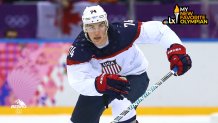Abby Roque grew up with hockey all around her: playing “shinny” in the backyard rink, following her NHL scout dad to arenas, watching film, talking about the game, learning all the way.
Now, Roque will be the first Indigenous woman to represent the United States women's ice hockey team at the Winter Olympics in Beijing, and she's the team’s only Black, Indigenous, or person of color (BIPOC) player.
On the latest episode of the “My New Favorite Olympian” podcast, hosts Ngozi Ekeledo and Apolo Ohno heard from Roque and some of those closest to her about loving the game of hockey, and the importance of representation on a stage where Indigenous people are rare.
"For me, hockey was so accessible and so part of my life that it never was truly a challenge for me to just fall in love with it and be playing it, where so many kids aren’t as lucky,” Roque said.
Listen to the full episode of My New Favorite Olympian
Roque started reckoning with her identity when she started playing hockey for the University of Wisconsin Badgers.
"That was when I started to realize how rare it is to get people of color in the sport," and when she started thinking more about her identity as something that should be discussed, Roque said.
Growing up in Michigan on the ancestral lands of the Ojibwe First Nation, Indigenous kids were about 20-25% of the teams Roque played on growing up, she estimated. That’s a stark contrast from the NHL, which is about 94% white.
But is hockey even a white sport? While Indigenous peoples have been credited with inventing lacrosse, the origins of hockey are less clear.
Patrick Wedaseh Madahbee, the former Grand Council Chief of the Anishinabek Nation, says the name “hockey” may come from an Indigenous way to say “ow” or “ouch”’: “ooglee.” Indigenous peoples played the game on an icy pond — using sticks to pass around a frosty horse turd, which was painful when it hit your shin.
And lacrosse and other games were used to settle differences between Indigenous peoples without bloodshed, Madahbee said.
That history, though, hasn’t translated to representation in modern hockey.
More From My New Favorite Olympian
Curling Has Been Mostly White For Centuries. These Athletes Are Trying to Expand Its Reach
Olympic Hopeful Timothy LeDuc Is Changing the Rigid Gender Roles in Pairs Figure Skating
Roque comes from a hockey family; her dad is Toronto Maple Leafs scout Jim Roque. She’s personally felt accepted and welcomed into the hockey world — even prior to college, when she was the only girl on a team full of boys in high school. (They made a small girl’s locker room just for her.) But despite that acceptance, Roque feels hockey hasn’t been very accessible for other BIPOC folks.
On the one hand, it’s expensive to get involved — so you have young athletes who are disproportionately from wealthy families that can afford pounds of gear. The average Indigenous family makes $23,000 a year, according to the Institute for Policy Research.
“The game is just — it is complicated and…it was never that inviting of a sport I think, unless you felt like you were an insider,” Roque said.
“And I think that's a big piece of what a lot of programs, and a lot of people in hockey are realizing is the issue with it,” Roque continued, “is that it was never that welcoming to people who aren't white, and even girls, for a long time. It wasn't a welcoming community. It was more of a white boys club kind of sport, where if you could afford it, you could play.”
There are programs that get more Indigenous kids playing and loving the sport. One is the Little Native Hockey League tournament, which has grown from 17 teams in 1971 to over 200 today.

“It’s gotten really big and we’ve had a number of players that have gone on, both male and female, gone on to play nationally, internationally,” said Madahbee, who’s been involved in the league for over 50 years. (In January, the Little NHL announced it would halt its third season in a row over COVID-19 safety concerns.)
And as more players like Abby make the big time, Indigenous stories can be told on a bigger platform. Established Indigenous players can be a role model for the younger generations. And some already have been: award-winning NHL coach Ted Nolan is one.
Washington Capitals right-winger T.J. Oshie, who is also of Ojibwe descent, has been an inspiration to Roque. She can still remember his legendary performance in a 2014 Olympic shootout, clinching the game for the U.S. against Russia.
“I feel a lot of pride that she was able to see that and that in one way or another motivated her to make that her goal,” Oshie said. “It means a lot to me…my dream and my career can make a positive impact on young Indigenous kids around the U.S.”
Roque wants to inspire younger generations too, and she’s following advice she picked up from her dad.
“You can be visible and any chance that you can, give back to the game in any way," Roque said. "You should always want to help more people play hockey."
To hear the full episode, subscribe to My New Favorite Olympian wherever you get your podcasts.
You can find more episodes of My New Favorite Olympian here.

